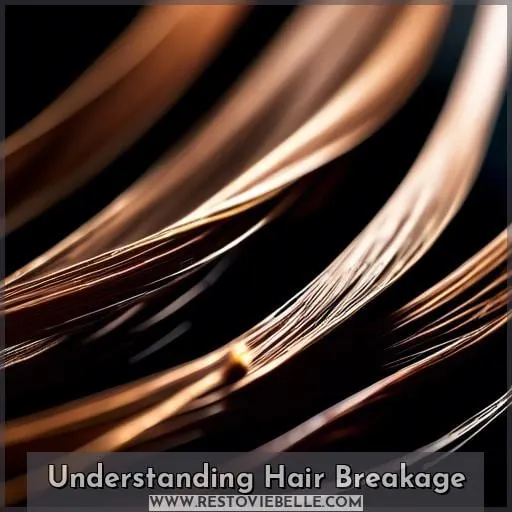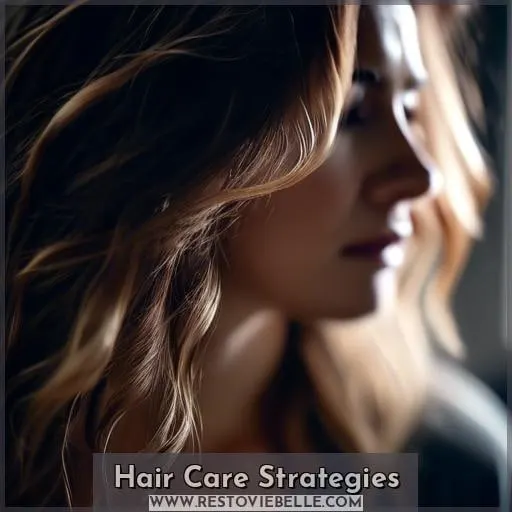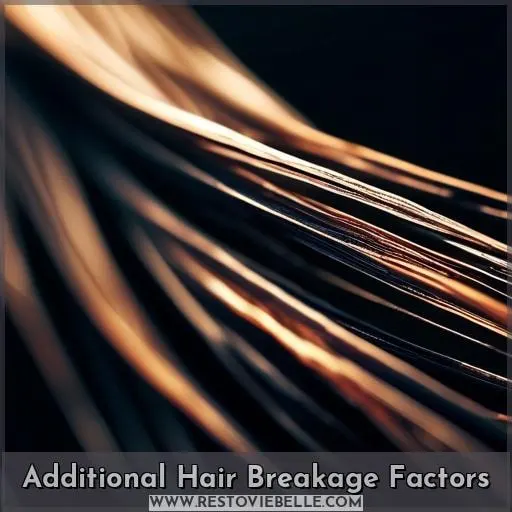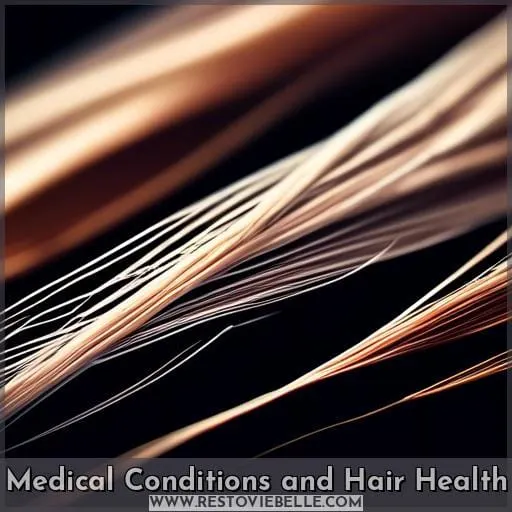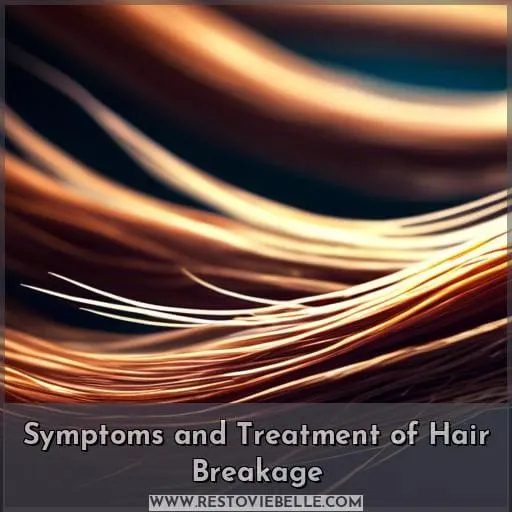This site is supported by our readers. We may earn a commission, at no cost to you, if you purchase through links.
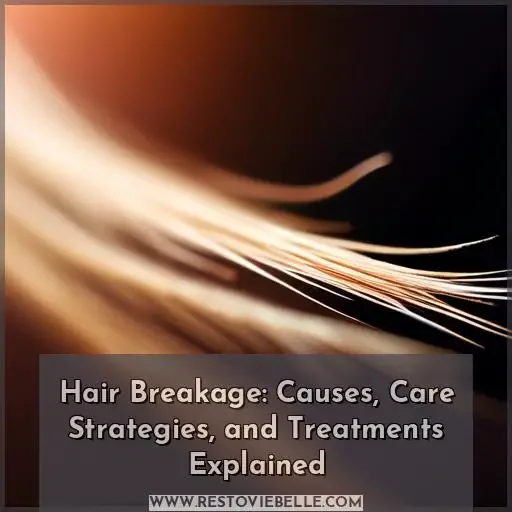 Struggling with hair breakage? You’re not alone. This common issue stems from various factors like harsh styling, nutritional gaps, and stress.
Struggling with hair breakage? You’re not alone. This common issue stems from various factors like harsh styling, nutritional gaps, and stress.
But don’t fret—there are ways to fortify your strands and reclaim healthy locks. Dive into the causes, care strategies, and treatments for hair breakage, and learn how to prevent future damage.
It’s time to take control and give your hair the strength it deserves.
Table Of Contents
- Key Takeaways
- Understanding Hair Breakage
- Hair Care Strategies
- Additional Hair Breakage Factors
- Medical Conditions and Hair Health
- Symptoms and Treatment of Hair Breakage
- Frequently Asked Questions (FAQs)
- Can hair breakage affect my overall health?
- Is it possible to reverse hair breakage once it has occurred?
- How does the water quality in my area contribute to hair breakage?
- Can hormonal changes during pregnancy or menopause significantly impact hair breakage?
- Are there any specific vitamins or minerals that, when deficient, can lead to increased hair breakage?
- Conclusion
Key Takeaways
- Hair breakage can result from a variety of factors including nutritional deficiencies, stress, dry hair, heat damage, and chemical treatments.
- Effective hair care strategies to prevent breakage include using gentle washing and conditioning products, drying hair without causing damage, managing weaves and extensions carefully, adopting low-maintenance hairstyles, and maintaining a nutrient-rich diet.
- Additional factors contributing to hair breakage include an oily scalp, improper towel drying, excessive use of hair ties, and harsh brushing or combing practices. Regular trimming is also important to remove split ends and prevent further breakage.
- Medical conditions such as hypothyroidism and eating disorders can negatively impact hair health, leading to breakage. Symptoms of hair breakage include split ends, uneven hair lengths, and a frizzy texture, with treatments ranging from over-the-counter and prescription medications to hair transplants and platelet-rich plasma injections.
Understanding Hair Breakage
If you’re noticing your hair lacks its usual luster and strength, it’s possible you’re experiencing hair breakage. This can stem from nutritional deficiencies, such as a lack of protein or vitamins, which are essential for maintaining healthy hair.
Additionally, external factors like heat styling, chemical treatments, and even the way you dry your hair can contribute to weakened strands and increased breakage. To address these issues, it’s important to adopt a hair care routine that minimizes damage and nourishes your hair, from the inside out.
Nutritional Deficiencies
Nutritional deficiencies play a significant role in hair health, affecting everything from hair growth to its strength and shine.
- Zinc Deficiency: Zinc is crucial for hair tissue growth and repair. Without enough zinc, you might notice your hair is losing its battle against breakage.
- Iron Deficiency: Iron helps carry oxygen to your hair’s roots, helping it grow strong and healthy. Low iron levels can leave your hair feeling weak and brittle.
- Protein Intake: Hair is primarily made of protein, so inadequate protein intake can result in weak hair prone to breakage. Ensure your diet is rich in protein to support hair health.
- Antioxidant Benefits: Antioxidants like vitamins A, C, and E combat oxidative stress that can weaken hair roots. Including foods rich in antioxidants can help maintain hair strength and prevent breakage.
Incorporating a balanced diet rich in essential nutrients like omega-3 fatty acids, biotin, and vitamins, along with using hair care products like coconut oil, can significantly improve hair health and reduce breakage.
Remember, your hair’s health is a reflection of your overall nutritional status.
Impact of Stress
Stress can wreak havoc on your hair, and understanding its impact is crucial for maintaining a healthy mane.
- Hormonal Havoc: Stress triggers the release of cortisol, a hormone that can push hair follicles into a resting phase, halting growth and leading to hair fall.
- Stem Cell Stalling: Under stress, hair follicle stem cells may become dormant, preventing the normal cycle of hair regeneration.
- Meditation Magic: Incorporating stress-reduction techniques like meditation can help lower cortisol levels, potentially reducing hair damage and promoting regrowth.
- Nutritional Necessity: High stress can affect your diet, leading to nutrient deficiencies that further contribute to hair breakage. Ensuring a balanced intake of vitamins and minerals is essential.
Dry Hair Concerns
Dry hair can be a real thorn in your side, or rather, a frizz in your locks. It’s like a garden without water—lack of moisture turns your mane into a brittle mess.
- Heat Styling Overload: Your hair’s not a fan of the hot stuff. Blow dryers, straighteners, and curling irons are like sunbathing without sunscreen for your tresses.
- Moisture MIA: Skipping conditioner is like forgetting to water those plants. Your hair needs that drink of moisture to stay supple.
- Chemical Warfare: Hair dyes and perms are the equivalent of a junk food diet for your hair—too much and it starts to break down.
- Environmental Elements: Just like your skin, your hair feels the burn from sun, wind, and harsh climates.
Heat Damage
Heat damage is a notorious culprit behind hair breakage, transforming your crowning glory into a frizzy, brittle mess. It’s like walking a tightrope; too much heat and you’re in for a world of hurt, but with the right precautions, you can still enjoy your favorite styles.
- Moderation is Key: Think of your hair styling tools as a double-edged sword. They can create stunning looks but wield them too often, and you risk damaging your hair. Limit the use of blow dryers, straighteners, and curling irons to special occasions or a few times a week at most.
- Protection, Protection, Protection: Before you even plug in your styling tool, make sure to apply a heat-protecting spray. This acts like a shield, minimizing the heat’s direct impact on your hair strands.
- Choose Wisely: Not all hair styling tools are created equal. Opt for those with adjustable heat settings and ceramic plates that distribute heat more evenly, reducing the chance of hot spots that can fry your hair.
- TLC for Your Tresses: After subjecting your hair to heat, give it some tender loving care. Use hair masks and deep conditioning treatments regularly to replenish moisture and repair damage.
Chemical Treatments
Chemical treatments can be a double-edged sword for your hair. They offer the transformation you crave but can also lead to damage that makes your strands cry out for help.
- Avoid Overprocessing: Space out those chemical treatments. Your hair’s not going anywhere, but its health might if you perm or color too frequently. Aim for a breather of 8-10 weeks between sessions.
- Choose Wisely: Not all dyes are created equal. Permanent dyes can be harsh, so consider semi-permanent options that are less aggressive and wash out after several shampoos.
- pH Matters: Alkaline shampoos can ruffle your hair’s feathers—literally. They can rough up the cuticle, leading to breakage. Opt for shampoos with a lower pH to keep things smooth.
- Condition, Condition, Condition: A good conditioner is like a peace treaty for your hair. It helps neutralize charge, detangle, and prevent those dreaded split ends. It’s your best ally in the battle against breakage.
Hair Care Strategies
To maintain healthy hair and prevent breakage, it’s crucial to adopt a hair care strategy that addresses the specific needs of your hair type and texture.
Effective washing and conditioning involve using gentle products and techniques that don’t strip hair of its natural oils, which can lead to dryness and breakage.
When drying your hair, opt for air drying whenever possible to minimize heat damage. Consider using a microfiber towel to gently blot excess water without causing friction.
Additionally, maintaining a nutrient-rich diet can provide your hair with the essential vitamins and minerals it needs to stay strong and resilient.
Effective Washing and Conditioning
When it comes to effective washing and conditioning as part of your hair care strategies, it’s essential to be gentle and mindful of the products you choose.
- Conditioner Selection: Always pick a conditioner tailored to your hair type. If you’ve been swimming, a swimmer’s shampoo and conditioner can help combat chlorine damage.
- Scalp Massaging: While shampooing, give your scalp a gentle massage. This not only feels great but can also promote blood flow, which may aid in hair growth.
- Hair Masks: Integrate hair masks into your routine. They’re like a spa day for your strands, providing deep conditioning and helping to repair damage.
Drying Without Damage
To dry your hair without causing damage, consider these hair care strategies:
- Air Drying: Embrace air drying to retain moisture. Your hair can lose moisture quickly with blow-drying, but air drying allows for a gradual reduction, helping to maintain hydration.
- Blotting: After washing, gently blot your hair with a towel instead of rubbing it. This method is less harsh and can reduce breakage.
- Protective Products: If you must use heat, apply a heat-protecting spray like John Frieda Frizz Ease to shield your hair from damage.
- Proper Tools: Use wide-tooth combs for detangling and natural bristle brushes for styling to minimize stress on your hair.
Incorporating these tips into your routine can help prevent hair breakage stress and promote healthier hair growth.
Managing Weaves and Extensions
When it comes to managing weaves and extensions, it’s crucial to approach their care with a blend of expertise and a touch of TLC.
- Weave Attachment: Ensure your weave is attached securely but not too tightly to avoid tension on your scalp and natural hair.
- Weave Maintenance: Regularly wash and condition your weave to maintain its luster and prevent buildup that can affect both the weave and your scalp health.
- Extension Health: Be gentle when styling your extensions to minimize damage. Use a wide-tooth comb or your fingers to detangle.
- Extension Removal: When it’s time to remove your extensions, do so carefully to avoid pulling out your natural hair. Give your hair a rest before reapplying.
Low-Maintenance Hairstyles
Embrace the beauty of simplicity with low-maintenance hairstyles that save time and keep your hair healthy. These styles require minimal daily care, reducing the need for constant styling products and hair accessories.
Plus, they’re perfect for those protective styles that keep your locks in check.
- The Classic Bob: A timeless cut that’s easy to manage and style, perfect for those who want to look put together without the fuss.
- Playful Pixie: Wake up with a bedhead that looks intentional; a pixie cut is the ultimate low-maintenance ‘do for the bold at heart.
- Natural Curls: Let your natural curls fly free with a wash ‘n’ go approach, using just a touch of leave-in conditioner to define and moisturize.
Nutrient-Rich Diet
Transitioning from low-maintenance hairstyles to a nutrient-rich diet is like swapping your old, frayed hair tie for a silk scarf. It’s all about upgrading to something that not only looks better but feels better too.
- Protein-packed eggs: Not just for breakfast anymore, they’re your hair’s best friend, giving it the strength to withstand whatever styling battle you put it through.
- Berry good antioxidants: Strawberries, blueberries, and their friends are like the superheroes of your diet, fighting off the damage-causing villains and keeping your locks luscious.
- Iron-clad spinach: This leafy green is like the iron shield for your hair, guarding against breakage and fueling your follicles with oxygen.
- Omega-3-rich fatty fish: Think of salmon as the moisturizer you never knew your hair needed, keeping it hydrated and happy from the inside out.
Additional Hair Breakage Factors
When addressing additional factors contributing to hair breakage, it’s crucial to consider the impact of an oily scalp, improper towel drying techniques, the type of hair ties used, brushing and combing practices, and the frequency of hair trimming.
Managing an oily scalp involves gentle shampooing and avoiding over-washing, which can exacerbate oil production and lead to conditions like dandruff or seborrheic dermatitis.
Towel drying should be done with care, using a soft microfiber towel to blot the hair gently instead of rubbing, to prevent weakening and fraying of the strands.
The choice of hair ties is also significant; opting for ones that minimize tension and friction can help avoid damage and breakage.
Brushing should be done with tools that are gentle on the hair, such as wide-tooth combs or natural bristle brushes, and it’s advisable to start detangling from the ends up to prevent unnecessary stress on the hair.
Lastly, regular trimming every 8 weeks can help remove split ends and prevent further breakage, maintaining the hair’s overall health and appearance.
Oily Scalp Management
Managing an oily scalp can be a slippery slope, but it’s essential for maintaining healthy hair and preventing breakage. If your scalp’s oil production is on overdrive, it’s like a non-stop oil well that can leave your locks looking more slick than sleek.
- Understand the oily scalp causes: Get to the root of the problem by identifying factors like genetics or hormonal changes that might be cranking up your scalp’s oil production.
- Tackle scalp overproduction: Sometimes, less is more. Overwashing can signal your scalp to produce even more oil, so find that shampoo sweet spot.
- Embrace sebum treatment: Look for products designed to balance sebum levels without stripping your scalp of its natural oils.
- Promote hair follicle health: A healthy scalp equals healthy hair. Gentle cleansing and proper nutrition support follicle function.
- Master oil absorption: On days when washing isn’t on the agenda, dry shampoo can be your best friend, sopping up excess oil and refreshing your hair.
Towel Drying Techniques
After managing an oily scalp, it’s crucial to focus on the right towel drying techniques to prevent further hair breakage.
- Blot, Don’t Rub: Gently press the towel against your hair to absorb moisture. Rubbing can create friction, leading to frizz and breakage.
- Use a Microfiber Towel: These towels are softer and more absorbent, reducing the need for rubbing and minimizing heat damage.
- Wrap Wisely: Instead of twisting your hair tightly in a towel, wrap it loosely to avoid pulling and stress on your hair roots.
- Limit Towel Time: Keep your hair wrapped just long enough to remove excess water, then let air drying take over to prevent stress from prolonged wrapping.
By adopting these techniques, you’re not just drying your hair; you’re embracing a ritual that respects its fragility when wet, paving the way for healthier, stronger locks.
Hair Tie Usage
Hair ties are a staple in most hair care routines, but they can also contribute to hair breakage if not used properly.
- Opt for hair tie alternatives: Instead of traditional elastic bands, consider gentle options like scrunchies or fabric-covered bands that minimize tension.
- Embrace protective hairstyles: Styles that tuck away ends and don’t pull tightly on roots, like loose braids or twists, can prevent damage.
- Incorporate hair care essentials: Use products that strengthen and moisturize your hair to make it more resilient against breakage from hair ties.
- Practice damage prevention: Be mindful when using hair ties. Don’t pull too tight, and give your hair a break from being tied up to avoid stress on the hair shaft.
Brushing and Combing
Switching from the previous topic of hair ties, let’s talk about brushing and combing—another critical factor in hair care.
- Brush Type: Opt for natural bristle brushes to smoothly distribute oils and add shine.
- Comb Width: Wide-tooth combs are your best friend for detangling without damage.
- Brush Frequency: Limit brushing to twice a day to avoid overstimulation of oil glands.
- Comb Material: Choose combs made of gentle materials like acetate to prevent static.
- Detangling Methods: Start from the ends and work your way up to minimize breakage.
Regular Trimming
To keep your locks looking luscious and prevent hair damage, regular trimming is a must. It’s like pruning a garden; you get rid of the old to make way for healthy growth.
- Trimming Results: Regular cuts prevent split end formation, keeping your hair smooth and reducing the need for future drastic chops.
- Maintenance Frequency: Aim to remove split ends every 8 weeks to keep your hair in tip-top shape and prevent breakage from traveling up the hair shaft.
- Split End Causes: Heat styling, harsh brushing, and environmental factors can all lead to split ends, but regular trims nip these pesky problems in the bud.
Medical Conditions and Hair Health
When considering the impact of medical conditions on hair health, it’s essential to recognize that both hypothyroidism and eating disorders can significantly contribute to hair breakage and loss.
Hypothyroidism can lead to slow-growing, coarse, and brittle hair, while eating disorders, due to malnutrition, can cause hair to thin, shed, and fall out due to keratin depletion.
Addressing these conditions holistically involves not only medical treatment for the underlying issues but also adopting a hair care routine that minimizes further damage and supports hair health.
Hypothyroidism
Continuing from the discussion on how various factors can lead to hair breakage, it’s important to understand that underlying medical conditions, such as hypothyroidism, can also play a significant role.
If you’re noticing your hair isn’t just throwing a tantrum but actually waving a white flag, it might be your thyroid hormone levels calling for attention. Hypothyroidism can sneak up on you, leaving your hair growth in slow-mo and turning your once luscious locks brittle and as lifeless as a forgotten houseplant.
- Thyroid hormone imbalances can lead to hair feeling like straw on a scarecrow.
- Hair loss might seem like it’s raining strands every time you brush.
- Low thyroid function can turn your hair’s growth cycle into a prolonged winter.
- Without enough thyroid hormone, your hair might stage a vanishing act worthy of a magic show.
Eating Disorders
When it comes to your hair, eating disorders can be silent saboteurs. Here’s the lowdown:
- Keratin Crisis: Your hair is keratin’s kingdom, but eating disorders like anorexia and bulimia can lead to a keratin coup, leaving your locks thin and lifeless.
- Nutritional Knockout: These disorders often result in a nutritional knockout, with deficiencies in protein and vital vitamins causing your hair to wave the white flag.
- Psychological Predicament: The psychological effects of eating disorders can trigger a stress response in your body, pushing hair follicles into a dormant state and leading to hair loss.
- Dietary Supplements: While dietary supplements can’t replace a balanced diet, they might help pick up the slack in the battle against breakage due to nutritional deficiencies.
Symptoms and Treatment of Hair Breakage
Recognizing the signs of hair breakage is crucial for addressing and treating the issue effectively.
If you’re noticing split ends, uneven hair lengths, or a frizzy texture, it’s likely your hair is suffering from breakage.
To combat this, incorporating a comprehensive care strategy that includes both preventive measures and targeted treatments is essential.
From adjusting your haircare routine to seeking professional advice for underlying medical conditions, a holistic approach can help restore your hair’s health and vitality.
Recognizing Hair Breakage
Recognizing the signs of hair breakage is crucial for addressing the underlying issues and seeking appropriate treatment. If you’re noticing more hairs on your brush or pillow, it might be time to take a closer look at your hair health.
- Breakage along the shaft: This can manifest as frizzy, rough texture, and uneven hair length, particularly with areas of shorter hair.
- Split ends: The ends of your hair may appear frayed or easily split, which can contribute to a lackluster appearance.
- Dry hair: Your hair might feel dry to the touch, lacking the softness and shine of healthy hair.
These symptoms can be caused by a variety of factors, including traction alopecia from tight hairstyles, telogen effluvium due to stress, thyroid disorders leading to brittle hair, eating disorders disrupting the hair growth cycle, and diet-related breakage from nutrient deficiencies.
To treat hair breakage, you might consider over-the-counter medications like Rogaine, prescription medications such as Propecia, hair transplant procedures, or platelet-rich plasma injections. However, prevention is often the best approach, which includes eating a balanced diet, managing stress, avoiding tight hairstyles, properly managing medical illnesses, and trimming damaged ends regularly.
If you’re experiencing excessive or unusual hair loss, brittle and dull hair, thinning hair with excessive shedding or bald patches, changes to skin and nails, or fatigue, it’s advisable to consult a doctor.
These symptoms may indicate an underlying health condition that requires medical attention.
Hair Loss Treatments
If you’re grappling with hair loss, don’t pull your hair out in frustration—there’s a raft of treatments to explore.
- Over-the-counter medications like Rogaine
- Prescription medications, including Propecia
- Hair transplant for a more permanent fix
- Platelet-rich plasma injections to stimulate growth
- Regular trims to nip breakage in the bud
These strategies could be your mane event for luscious locks!
Preventative Measures
To seamlessly transition from discussing hair loss treatments to preventative measures, it’s crucial to understand that prevention is always better than cure. You’ve got to nip hair breakage in the bud before it escalates into a full-blown mane meltdown.
- Ditch the heat: Give your hair a break from the blow dryer and let it air dry.
- Be gentle: Treat wet hair like a delicate silk blouse—handle with care.
- Mix it up: Avoid the ponytail dent by changing your hairstyle often.
- Eat well: Your hair craves a balanced diet just as much as your body does.
- Trim the split ends: Regular trims keep your hair looking sharp and prevent further damage.
When to Consult a Doctor
When it comes to hair breakage, it’s crucial to understand when professional help is needed. If you’re noticing persistent issues with your hair, such as excessive breakage, thinning, or changes in texture, it may be time to consult a doctor.
- Unusual Hair Loss: If you’re experiencing more hair loss than usual or developing bald patches, it’s important to get checked out.
- Changes in Hair Texture: Brittle, dry, or dull hair that doesn’t improve with home care could indicate an underlying issue.
- Overall Health Concerns: If you’re also experiencing fatigue or changes in your skin and nails, it could be a sign of a more serious health condition.
Frequently Asked Questions (FAQs)
Can hair breakage affect my overall health?
Hair breakage itself doesn’t directly affect your overall health, but it can be a sign of underlying health issues or nutritional deficiencies.
If you’re noticing more breakage than usual, it’s worth taking a closer look at your diet, stress levels, and hair care routine.
So, if your mane’s looking more frazzled than fabulous, it might be time to nourish from within and ease up on the styling heat.
Is it possible to reverse hair breakage once it has occurred?
You can’t turn back time on split ends, but you can mend your mane’s ways.
Think of your hair like a cherished garden; regular trims prune away the damage, while nourishing treatments and a balanced diet water the roots, encouraging lush, healthy growth.
How does the water quality in my area contribute to hair breakage?
Hard water in your area can be tough on your tresses. It’s loaded with minerals like calcium and magnesium that can build up on your hair.
Can hormonal changes during pregnancy or menopause significantly impact hair breakage?
Yes, hormonal changes during pregnancy and menopause can significantly impact hair breakage.
During pregnancy, elevated estrogen levels often lead to fuller, thicker hair. However, postpartum hormonal adjustments can cause shedding and breakage.
Menopause brings a decrease in estrogen and progesterone, making hair thinner and more prone to breakage. Nearly 50% of women experience noticeable hair thinning by age 50 due to these hormonal shifts.
To combat this, adopting a holistic approach that includes a balanced diet, stress management, and gentle hair care can help maintain hair health during these hormonal changes.
Are there any specific vitamins or minerals that, when deficient, can lead to increased hair breakage?
Deficiencies in vitamins D, B (especially biotin), C, E, and minerals like iron, zinc, and selenium can lead to increased hair breakage.
Ensuring you’re not skimping on these can be a real mane-saver!
Conclusion
Tending to your tresses isn’t just about vanity—it’s about health and self-care. Nourishing your hair from the inside out with a balanced diet, and protecting it from the outside with gentle styling, can turn the tide on hair breakage.
Embrace these holistic habits, and you’ll be on your way to stronger, healthier hair.
